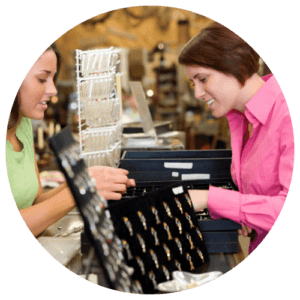What does it mean to be deaf-friendly?
Not just a viral hashtag, #deaffriendly has signaled a paradigm shift in recent years. That is to say, It reflects an emboldened consumer demographic — one with more information, more choices, and 9 Billion in discretionary income to spend.
Being deaf-friendly is a commitment to making business easier for consumers who are all too accustomed to communication barriers.
The barriers go beyond the cash register. They touch every aspect of the consumer experience: from calling customer support to troubleshoot a product, to getting interpreters for an event you’re hosting, to abandoning a website due to an un-captioned promotional video.
Once communication starts to crumble, the chance to keep a lifetime consumer drops too.
With so many parts of the communication chain, what exactly does it mean to be deaf-friendly? Here are three of the top examples many deaf consumers rave about:


To be deaf-friendly, your public-facing staff enunciates clearly.
Some deaf and hard of hearing people develop an ability to “read” speech. Equally, some become so skilled, they nab speechreading jobs for football teams and the FBI alike. However, this is a rarity. Furthermore, Speechreading is a skill that not all deaf people possess.
Make continual eye contact, and move your lips at a normal pace. If you run a restaurant, be willing to turn the lights up. The “dim, romantic lighting” at many upscale eateries is anything but romantic for deaf diners struggling to speechread!

You proactively budget for a deaf-friendly environment by providing sign language interpreters and captioning services.
It means formally writing down how much you’ll budget for interpreter requests. First things to remember; Do you have qualified interpreters handy? Will you need two interpreters or one? Have you had a conversation with your tax professional about making this form of accommodation a line item in your annual operating budget — and reaping tax credits?
Logistics aside, a deaf-friendly business will honor and respect the cultural importance of interpreting services.
It is equally important to recognize that not all deaf and hard of hearing people know how to sign; and to be aware that some may request CART (Communication Access Real-Time Translation) services instead.

Your technology is up to snuff … but for deaf-friendly purposes, you don’t rely on it to do all the work.
Some business transactions are too involved and lengthy to rely on pointing, gestures, and paper and pen. At the present time, examples include a doctor’s visit, an educational workshop or legal situation.
Technology is a powerful way for Deaf or hard of hearing people to get the most out of their daily lives. But there are three rules about deaf-friendly technology usage: one, it should work properly ALL the time; two, it shouldn’t replace human connection; three, it should be upgraded to what deaf people currently use.


Why Be Deaf-Friendly?
Often, businesses fret about the cost of being deaf-friendly. Indeed, in the the bigger reality: In every industry, it pays to be deaf-friendly. Even more so; Hospitality chains can drive repeat business for years. In the long run; A mom-and-pop operation with a limited marketing budget can reap serious word-of-mouth within the Deaf Community.
As a matter of fact; In the medical field, being more proactive about meeting Deaf and Hard of Hearing patients’ communication needs can significantly drive down expensive malpractice risk.
Committing to being deaf-friendly is the most risk-averse move you could make. Consider the U.S. demographic ticking clock: More than 1 billion people in the world have a disability, according to the World Bank. Throw in our massive population of aging Baby Boomers, and it’s inevitable that most everyone will live with disability at some point during their lives.
So why should you pay particular attention to the Deaf Community? Because of all disability types, not to mention, the demographic with hearing difficulties encompasses the highest discretionary income by far: $9 billion dollars. Moreover, the second-highest disability group represents only $3 billion, according to an April 2018 report called “An Undervalued Market: The Purchasing Power of People With Disabilities.”
By being mindful of the full spectrum of hearing loss, you can also see the larger picture of disability — including vision, mobility, cognitive, and independent living.
Changing the way we think about accessibility is a start. Straightaway, it means thinking beyond checking off the wheelchair ramp part of your list. Instead, being deaf-friendly means understanding “access” as an individual’s complete, end-to-end experience of your product or service. Furthermore, this thought process builds empathy, which drives product innovation and other unforeseen benefits (like better design and User Experience).
Lastly, Inclusion is a joyful way of being that benefits all of your customers. Undoubtedly, this is our goal at deaffriendly: To help you incorporate this way of thinking into your company, so seamlessly that it simply becomes an everyday part of doing business.
RidicuLIST: Deaf people can’t enjoy music
As someone who is deaf, I’ve heard (pun) my fair share of ridiculous statements about deaf people. One of them that keeps coming up, deaf people cannot enjoy music. As a music lover myself, I am here to set the record straight: deaf people CAN enjoy music. Music is not [...]
5 customer service fails when serving deaf and hard of hearing customers: holiday edition
With the holidays around the corner, customer service sometimes changes for the worst. How does that bode for deaf and hard of hearing customers who are trying to survive the most credit-disrupting, nerve-wracking, and elbow-jostling season of the year? This holiday, are you prepared to provide deaf-friendly customer service? We [...]
New Deaf-Friendly Museum Training empowers museum professionals to create more accessible experiences
Think “museum,” and the first things that come to mind are iconic T-Rex displays of your childhood, or heist and adventure movies (think: The Mummy Returns, Thomas Crown Affair, and National Treasure). But unlike the relics inside, museums are evolving - just like the humans who create and visit them. [...]



